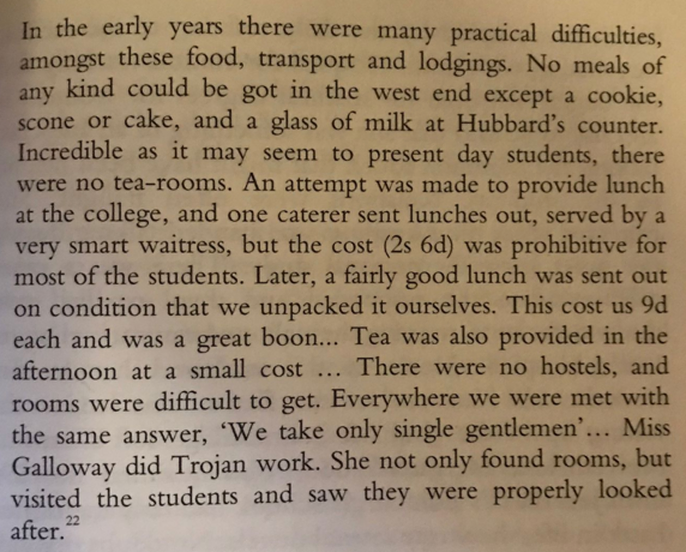Living conditions
From the very beginning female medical students struggled to find suitable student accommodation. Elizabeth Blackwell, the first registered female doctor (1847) who applied 28 times before finally being accepted to study at the Geneva Medical College, New York, came up against landladies wondering “why she was trying to be a man” and suspecting her of being an abortionist. Upon eventually finding somewhere to stay she was faced with being insulted and made to feel unwelcome walking through the neighbourhood to classes. Even later, as a qualified doctor working in Paris, she was treated like a nursing aide and made to sleep in a hospital dormitory with 16 loud ‘peasant’ girls, getting little to no privacy and having to share a bath with them.
When Jex-Blake and Pechey first arrived in Edinburgh they stayed at number 15 Buccleuch place, which quickly became the headquarters for the Edinburgh 7. By 1871, Thorne and her four children and a maid were living here and Evans and Chaplin resided in nearby lodgings. Moving to London, Jex-Blake co-founded the New London School for Women in Henrietta street in 1874. The women learned anatomy in a garden dissection room which had poor lighting and water supply and was not weather-durable. Their chemistry and physiology classes were also in the garden and were of poor quality for the intended learning. The girls could get one good midday meal for a shilling and their clothes were washed for them during term time only. In the winter of 1880-81, the pipes froze and the women were forced to fill kettles with snow and find coal and wood to clean and wash their hands. The clinical teaching at this time was undertaken at the Royal Free Hospital, where the women were allocated a ‘small and overcrowded’ cloakroom and sitting room. In 1882 the University of London opened the first college hall for female students and gave the women their first chance to mix with students from other courses, allowing them to develop new social and sporting interests and be involved in societies.
In 1886, Jex-Blake moved back to Edinburgh and set up the Edinburgh School for Women. It soon became clear that the students would not receive the same level of welfare and health support here as in London. Jex-Blake was pre-occupied with the daily running of her school, negotiating with Leith hospital for clinical teaching and continuing to campaign on a national level for women’s rights in medicine. She banned talking during the daily hour of personal study and was very strict regarding punctuality, eventually expelling two students who spent too long at a clinical teaching session. Rivals took advantage of this flaw and set up the Medical College for Women to compete for the now growing group of female doctor hopefuls. Due to Jex-Blake’s reputation as being overly authoritative, one student, Agnes Bennett from Australia, chose to study at the Medical College and wrote the passage below about having to find lodging to stay in.

Eventually she was forced out by the landlady’s drunk and unruly nephew whom she feared and eventually found refuge in a hostel set-up by Elsie Inglis. Some women who were more well off, such as Edith Brown who in 1887 documented sharing a two room flat with a friend and getting up early to light a fire and cook porridge and eggs, having a cheap meal in a restaurant at midday everyday and purchasing a roast potato from a roadside seller on her way home in the evening and having a woman come in and cook her dinner, were clearly less troubled by the lack of university provided accommodation for female students. In the West as the study of medicine for women commenced at the Queen Margaret College in 1890/91 the conditions were no better. Marion Gilchrist, the first female graduate of medicine from a Scottish university wrote the following excerpt of her time as a student.

In the 1890s the Edinburgh Association for the University Education of Women began providing facilities for female students, including a reading room, committee room and kitchen for 10/6d a year partially funded by Elsie Inglis. In 1897 Masson Hall in George Square was opened as the first women’s halls at the University. A women’s union was founded in 1905, giving female medical students their first real opportunity to demonstrate independent political expression. In 1920 the women’s union moved to beside the men’s union in George Square but remained separate. So, even into the early 1900s there were only two hostels for women, but most were forced into lodgings where the landladies would cook, wash and mend for them but were strict. The university had no responsibility for these hostels nor the sports, health or welfare of their female students.
References
Eileen Crofton. (2013). A Painful Inch to Gain.
Bell E Moberly. (1953). Storming the Citadel: the Rise of the Woman Doctor




Recent comments